Today I found a mystery awaiting me at the allotment. Ever seen this many bees under a hive? Just hanging out? And bees with pollen disappearing within their midst?
Usually you might get maybe a couple of bees wandering around under the floor. I had several thousand. I had a look through the hive to see if that might help solve the mystery. And found these:
Both of the two queen cells which were capped last week are now empty. The only brood left in the hive now is sealed. Either I have one queen or two – possibly there was a fatal fight, perhaps the older queen stung the younger one while she was still in the cell, or possibly one queen left with a swarm.
All looked well at the entrance, the bees were enjoying the sunshine after a pretty miserable and rainy week.
I texted Tom about the mysterious cluster. He very kindly volunteered to come and help, as he thought it best to take the hive apart, turn the hive floor upside down and shake the bees back in. I am glad he could help as the colony is a big ‘un on two brood boxes and a super, making for a lot of heavy lifting.
Having pulled all the boxes off, Tom turned the floor upside down, revealing the huge mass of bees collected there. He rested the floor on one of the brood boxes and the bees immediately quietly began walking down into the darkness of the frames. I didn’t fancy our chances of spotting any queen present in the midst of all the bees. Then suddenly Tom saw her – a lovely dark and surely mated queen, her abdomen longer than that of a virgin. After a bit of walking about, down she went too.
While all this was going on, bees were flying all over the place as returning foragers were coming home to find their hive mysteriously missing. So it was a bit awkward that one of the other allotment holders chose that moment to bring her two young children over to look at the bees through the netting. While she told them how gentle the bees are, Tom and I were nervously hoping no stings were about to occur.
After they had left, we put the hive back together and peace was restored. So what happened? Well, Tom has a theory that after her mating flight the queen came home and got confused – instead of going in the entrance she went under the hive. There had been a large amount of bees clustering under the hive last weekend too, possibly to keep cool. She may have smelled their Nasonov glands and thought under the hive was the place to be. I am glad she’s not out in the cold tonight.
The curious thing is, queens are only supposed to be ready to mate 5-6 days after emerging. I inspected last Saturday and the cells were still sealed. If she emerged last Sunday, the earliest she would have been ready to mate would have been Thursday, a very rainy day. Did she only just go out to mate yesterday? Would her ovaries have developed enough to make her a full sized queen already? Or did I somehow miss an older queen cell – not impossible, with three boxes to inspect. Another beekeeping mystery.
I’ll finish with another mystery – a pretty pink flower which I saw a bumblebee enjoying. I’m hoping someone will know what it is.
EDIT: Many kind people have now told me it’s comfrey. Lindylou has commented: “I think it’s Comfrey too. In English sometimes referred to as knitbone because of its healing components. Let dogs eat it if they want too it is good for them if they are experiencing leg and hip pain. You can roll mince etc. up in it like you can with cabbage and grape leaves too.”
And nessaplantlover says “your mystery flower is comfrey. I have plants with white flowers and purple flowers. Cut the plant back and put on the compost heap or put it in a big bucket ifvwater and leave for a couple of weeks to fester. It will stink but you can then use the stinky water diluted to feed your garden plants or your veggies. They will love it.”

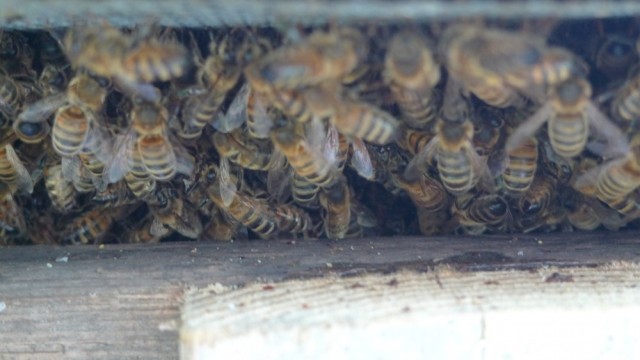

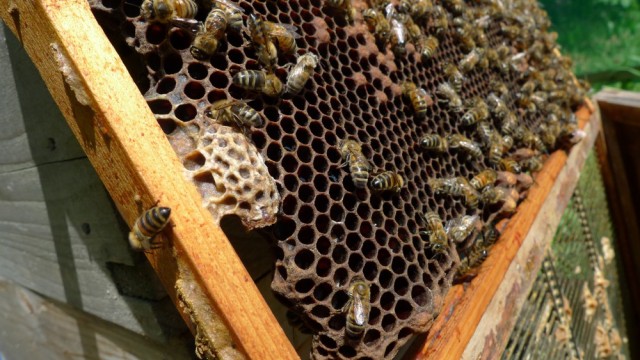
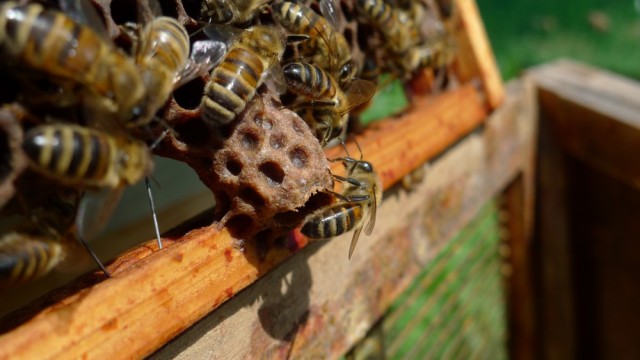
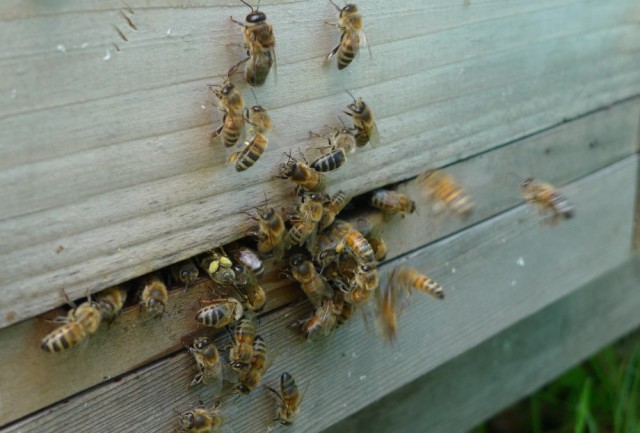
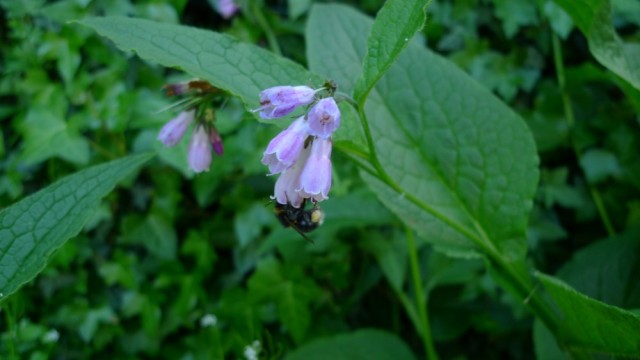
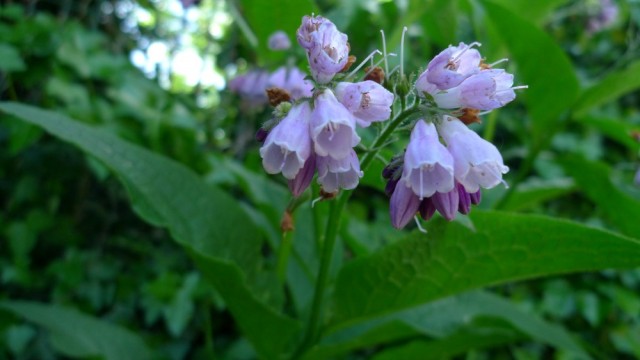
Not sure of your flower, but the bee story was interesting. If that was a new queen, where was the original, at the top of the hive?
LikeLike
Sorry Donna, I should have explained that two weeks ago, when the queen cells were spotted, the original queen was removed into a nucleus hive.
LikeLike
Very interesting Emily, a friend called me last year wondering why her bees were clustering below the hive…now I think I know why! BTW I think your flower is Comfrey: big fave of bumblebees in my yard and the leaves are high in nitrogen so are great for composting.
LikeLike
Could be – it is unusual but Tom has seen it happen to a friend of his before. Thanks for naming the flower!
LikeLike
What a great story. Thanks for sharing.
LikeLike
Thanks Erik.
LikeLike
I think it’s Comfrey too. In English sometimes referred to as knitbone because of its healing components. Let dogs eat it if they want too it is good for them if they are experiencing leg and hip pain. You can roll mince etc. up in it like you can with cabbage and grape leaves too.
LikeLike
Interesting, thanks!
LikeLike
Sounds like Stella’s bees are flourishing and doing so well! 🙂 They have a lovely allotment home, why would they want to leave? The queen probably saw this sense and returned home as Tom says 😉
LikeLike
It is a beautiful allotment! I was thinking of calling Stella’s daughters Stella II and III, but have decided that’s a bit boring. Probably going to go for space themed names next…
LikeLiked by 1 person
Lots of names in space! How exciting, planets, stars, comets… Just remember the beekeeper who named his queen after famous female explorers (Amelia for Earhart) and then she up and flew away! 😉
LikeLike
Oh dear, using space names could prove dangerous. Perhaps I should go for namesakes famous for staying at home and having plenty of children instead. Um, Queen Victoria? The old woman who lived in a shoe?
LikeLiked by 1 person
It does sound as if her navigation skills were just a bit off but it must have been so comforting to see your new queen go into the hive. Do you mark your queens? Amelia
LikeLike
It was a big relief! In the last couple of years I’ve got out of the habit of queen marking. It does help having someone else to help, as they can hold the frame and watch the queen while you hunt for the queen marking kit.
LikeLike
Hi emily. I had a queen in the wring place last week. Its my first full year as a beekeeper and they are certainly putting me to the test! My queen had managed to get through her queen excluder into the super above it & was laying like a trooper so brood everywhere. She was found & put back in the brood box where she belongs & put on a different QE. A fair amount of drones up there so I had to shake them all into the brood box yesterday after leaving them a week to hatch.
I agree with other answers here…yyour mystery flower is comfrey. I have plants with white flowers and purple flowers. Cut the plant back and put on the compost heap or put it in a big bucket ifvwater and leave for a couple of weeks to fester. It will stink but you can then use the stinky water diluted to feed your garden plants or your veggies. They will love it.
LikeLike
That is such a pain when queens get through the excluders. Thanks for the comfrey info. There was not much of it, so I wonder whether other allotment people have been using that tip already!
LikeLike
Hi Emily, My wife thinks your mystery flower may be Pulmonaria, I enjoy reading your blog, and am always impressed with your fabulous pictures. Best wishes Alan Jones
LikeLike
Thanks Alan, really glad you enjoy the blog! My photography technique is very basic but I try my best!
LikeLike
I agree its comfrey, I have some at the bottom of the garden and it often has 4 or more bumblebees on it when the sun shines
LikeLike
Brilliant!
LikeLike
Hi Emily, I would like to propose an alternative suggestion. Your queen cells are not broken down so I suspect the queens emerged recently. This fits with your timeline. She (or they) may have been on short orientation flights but she will not have ventured out on mating flights because she was not sexually mature yet.
I suspect that what has happened is that both queens emerged and one decided to escape. Rather than generating a ‘cast’ the virgin queen and her entourage simply crawled under the hive. It may be that she was damaged in the queen fight and could not fly. So I think that you had a queen both inside and underneath your hive. When you combined them again then the weakest queen will probably have been dispatched.
There are divided options on how many queen cells to leave in your situation. If I see a good sized, well worked, open queen cell with a larvae in it then I will definitely only keep one. If the cells are sealed then it is a more difficult decision but I will still tend to only keep one. I have too often been caught out with a swarm or a cast because I have left the colony with the option of generating two queens. If the colony is small such as a nuc then there may not be a problem, but with a large colony I have always had more problems leaving two queen cells.
Thanks for sharing your story.
LikeLike
Thanks Barny, that is an intriguing explanation and it may well be that I had two queens before Saturday. But I do not think the one under the hive was still a virgin when we saw her, her abdomen was long and full-sized like a mated queen. But that does not rule out your theory as she could have mated on the Friday.
Perhaps I should rethink my usual policy of leaving two cells. The trouble is, I worry that I will pick the wrong one and leave the colony in trouble! I see the second cell as insurance.
LikeLike
Yes I know that it is quite common for beekeepers to be nervous and select two queen cells as an insurance policy but from my personal experience, and more importantly the advice of several Master Beekeepers, you run a higher risk of problems but having two virgins queens. It does take a strong nerve but every time that I have not been bold enough, I have regretted it.
All the best,
Barny
LikeLike
Thanks Barny. By the way, why choose one unsealed cell rather than a sealed one, doesn’t that delay the process of getting a mated queen by a few more days?
LikeLike
If a queen cell is sealed then you do not know what is inside. Is it a dud or is there a viable queen pupating in there? I much prefer to chose a open cell (as close to being sealed as possible) so that you can see a nice juicy larvae in a pool of royal jelly. I then feel much more confident to keep that as the sole queen cell.
LikeLike
I think Barney has the answer – 2 queens – and it could be that if it was raining, one and her group may have gone under the hive to stay dry. The queen cells pictured are emerged cells – if an emerged queen had killed another in the un-emerged queen’s cell the side of the cell would have be destroyed, not a clean bottom exit. Although it’s best if the virgin queens get out for three days, 5-7 days after emergence, they can keep trying to mate for up to two weeks – but each day makes the resulting brood less viable (at least that’s what I’ve been told). Great post
LikeLike
Thanks Karen, yes thinking about it you’re right, those are both emerged cells. So there were two queens alive at one point.
That queen under the hive was no virgin though, so her wings were not damaged. And then why stay when she had a couple of sunny days in which to leave on the Friday and Saturday? Possibly she would have left soon, or perhaps she had already killed the other queen and saw that hive as her own. In which case Tom’s theory that she simply missed the entrance and mistakenly went underneath when returning from the mating flight makes sense.
I guess we’ll never know, bees are full of mysteries!
LikeLike
Your mystery flower is comfrey, beloved of bumblebees and other pollinators.
LikeLike
Thank you, another vote for comfrey! It seems pretty rare round here.
LikeLike
Phew! Sounds like having bees is more complex than having children! Fascinating.
LikeLike
Ha ha! The advantage is no screaming during the night, but then my cat does that instead.
LikeLiked by 1 person
A book called “The bee keeper’s Problem Solver” came in today’s post. Pages 66 and 67 deal with the problem “A swarm has clustered beneath the Parent Hive” What a coincidence! I only signed up to this blog today. Thank you for all the interesting contributions. I have had a really enjoyable morning reading them.
LikeLike
Brilliant! That book sounds good. What was the advice to solve the problem, was it any different from what I ended up doing?
LikeLike